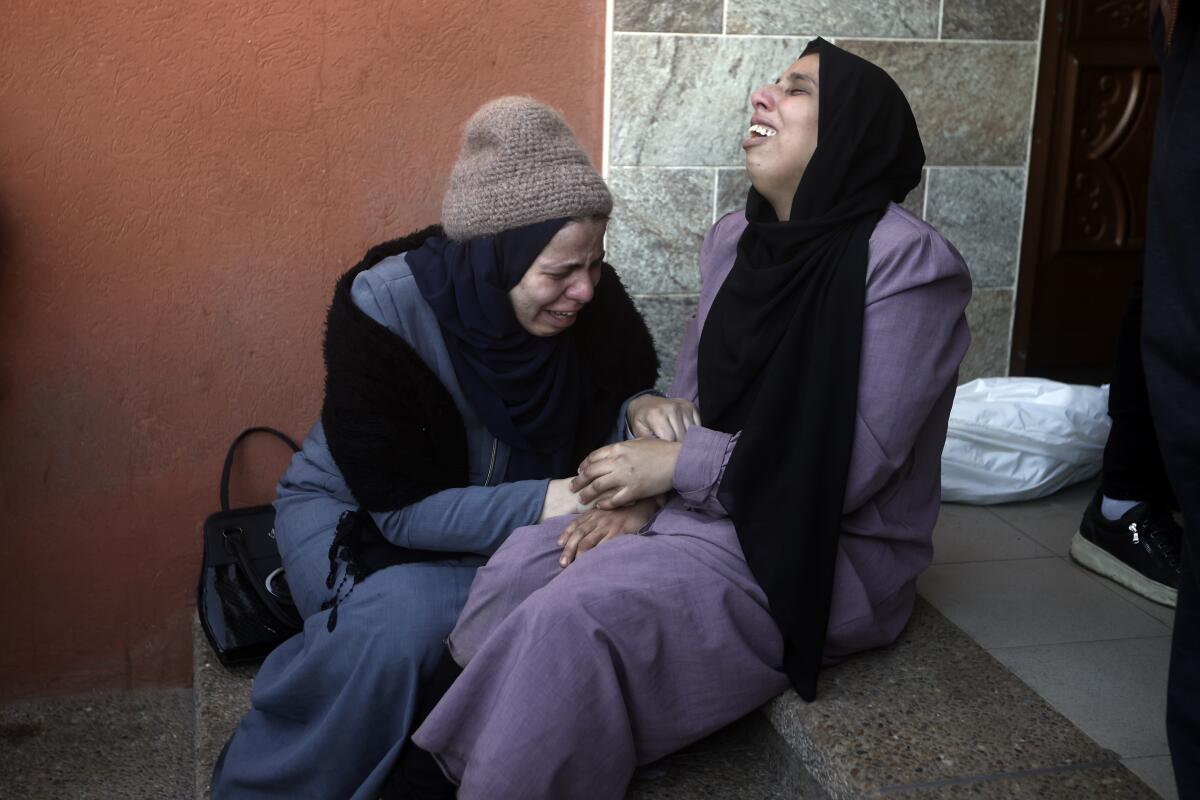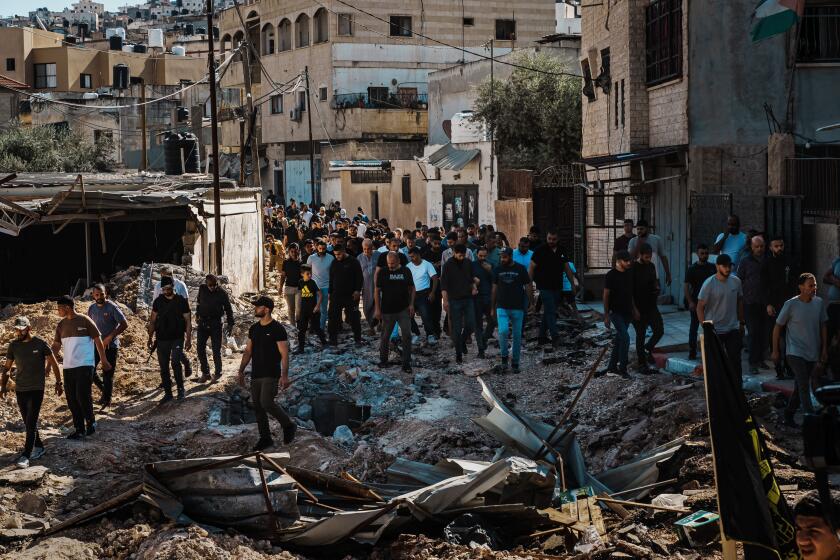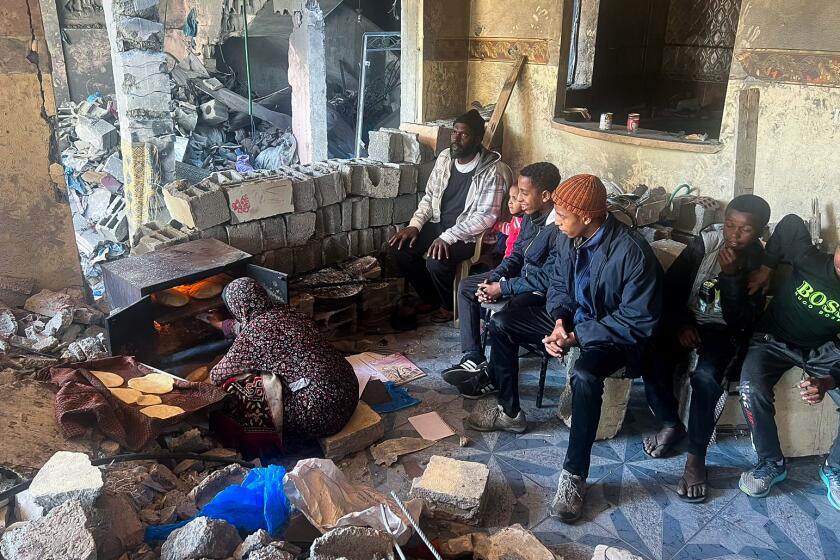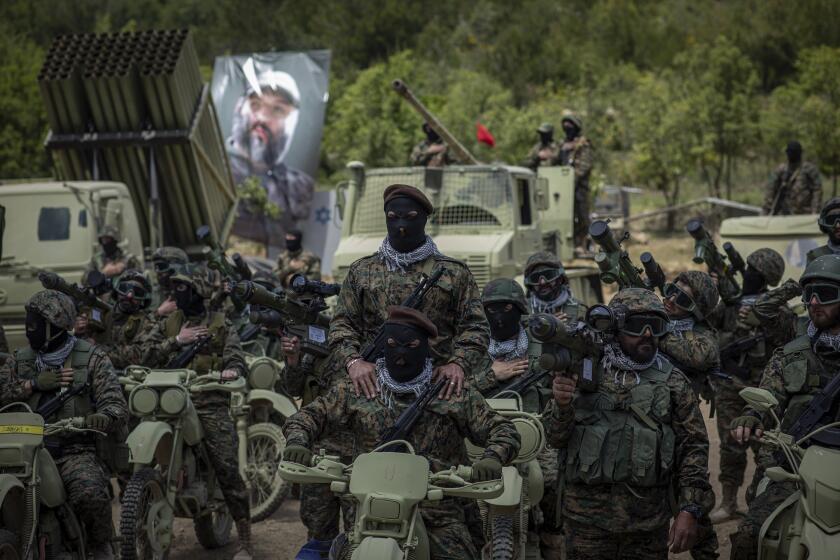Israeli defense minister lays out vision for next steps of Gaza war ahead of Blinken visit

- Share via
RAFAH, Gaza Strip — Israel’s defense minister on Thursday laid out his plan for the next phase of the war in Gaza, describing how Israeli forces would shift to an apparently scaled-down “new combat approach” in northern Gaza, while continuing to fight Hamas in the south of the territory “for as long as necessary.”
Ahead of a visit by U.S. Secretary of State Antony J. Blinken, Yoav Gallant also outlined a proposal for how Gaza would be run if Hamas is defeated, with Israel keeping security control while an undefined, Israeli-guided Palestinian body runs day-to-day administration, and the U.S. and other countries oversee rebuilding.
Israel has come under heavy international pressure to spell out a postwar vision but so far has not done so. The issue is likely to be on the agenda in Blinken’s talks this weekend in Israel and other countries in the region. The United States has pressed Israel to shift to lower-intensity military operations in Gaza that more precisely target Hamas, after nearly three devastating months of bombardment and ground assaults.
The vagueness of many of Gallant’s provisions made it difficult to assess how much they mesh with the U.S. calls.
The document issued by Gallant was titled a “vision for Phase 3” of the war, and Gallant’s office said the phase had not yet begun. It also said the ideas were Gallant’s and not official policy, which would have to be set by Israel’s war and security cabinets.
Gallant, who is a member of both cabinets, may be aiming to put his personal plan before the Americans ahead of others in Prime Minister Benjamin Netanyahu’s coalition, which includes hard-right members likely to want a tougher approach.
Palestinians in Jenin refugee camp, a center of West Bank resistance, say repeated Israeli raids appear intended to make their city as uninhabitable as Gaza.
After nearly three months, Israel’s bombardment and ground assaults have killed more than 22,400 people in Gaza, more than two-thirds of them women and children, according to the Health Ministry in the Hamas-run territory. The ministry count does not differentiate between civilians and combatants.
Israel has vowed to destroy Hamas after its Oct. 7 attack, in which militants killed some 1,200 people and abducted around 240 others.
Much of northern Gaza, which troops invaded two months ago, has been flattened beyond recognition. Associated Press video from Gaza City showed people wandering through a shattered landscape with large fields of broken concrete and splintered wood and streets lined with toppled buildings.
With the focus now in the south, Israeli forces are battling Hamas militants in the southern city of Khan Yunis and in urban refugee camps in the center of the territory.
Some 85% of Gaza’s 2.3 million people have been driven from their homes and squeezed into smaller slivers of the territory. Israel’s siege of the territory has caused a humanitarian crisis, with a quarter of the population starving because not enough supplies are entering, according to the U.N.
At the same time, airstrikes and shelling across Gaza continue to destroy houses, burying families taking shelter inside.
‘I just don’t know where we’ll go.’ It’s a question Palestinians ask over and over in Gaza as Israel ramps up bombardment after Hamas truce collapsed.
On Thursday, a strike flattened a house in Mawasi, a small rural strip on Gaza’s southern coastline where Israel’s military has said Palestinians should flee to escape the combat zone. The blast killed a man and his wife, seven of their children and three other children ages 5 to 14, according to a list of the dead who arrived at Nasser Hospital in Khan Yunis.
There was no immediate response from Israel’s military.
Gallant’s statement underlined that the war would go on until Hamas’ military and government capabilities are eliminated and the more than 100 hostages still in captivity are returned.
In the north, the statement said, forces will shift to a new approach that includes raids, destruction of tunnels, “air and ground activities and special operations.” The aim would be “the erosion” of the remaining Hamas presence.
There was no word whether northern Gaza’s population, which has almost entirely been driven south, would be allowed to return.
The statement did not clarify how the new approach would differ from current operations, but Gallant has previously said it would be a lower scale. Israel began last week to withdraw some troops from northern Gaza, where the military says it has largely gained operational control after weeks of heavy fighting with Hamas. Still, Gallant has said several thousand Hamas fighters remain there.
In the south, he said, fighting would continue “as long as is deemed necessary.”
After the war, the statement said, Israel will keep security control, taking military action in Gaza when necessary to ensure there are no threats and maintaining inspections of all goods entering the territory.
Gallant said there would be no Israeli civilians in Gaza, ruling out calls by some among Israel’s far right for a return of Jewish settlers to the territory.
Israel withdrew its troops and settlers from Gaza in 2005 after a 38-year presence.
Palestinian entities — apparently local civil servants or communal leaders — would run the territory, with Israel providing “information to guide civilian operations,” the statement said without elaborating. A multinational task force, led by the U.S., would be in charge of rebuilding.
The apparent picture of an Israeli-dominated Palestinian administration for Gaza differs starkly from U.S. calls for a revitalized Palestinian Authority to take control of the territory and a start to new negotiations toward creating a Palestinian state alongside Israel. Netanyahu and other Israeli officials have rejected that idea.
An apparent Israeli strike that killed a top Hamas leader near Beirut this week has stirred fresh fears that the conflict could expand into other parts of the Middle East — a prospect that is also likely to be high on Blinken’s agenda.
Lebanon-based Hezbollah is holding back from all-out war with Israel for now — but chances of a dangerous miscalculation by either side are high.
The killing of Sameh Arouri prompted warnings of retaliation from Hamas’ ally, the Lebanese Hezbollah militia. But there was no immediate escalation in the daily exchanges of rocket fire and shells between Hezbollah and the Israeli military over the two countries’ border.
Regional tensions climbed as a U.S. airstrike killed an Iranian-backed militia leader in Iraq and as Yemen’s Houthi rebels continued attacks on ships in key Red Sea shipping lanes.
At the same time, Israel has stepped up warnings of tougher military action against Hezbollah unless it pulls its fighters out of the border region, as called for under a U.N.-brokered 2006 cease-fire. Israel says that is the only way tens of thousands of Israelis who evacuated from communities in the north can return.
Gallant said Thursday that there was a “short window of time” for diplomacy with Hezbollah.
But he said Israel was determined to bring about “a new reality in the northern arena, which will enable the secure return of our citizens.”
More to Read
Sign up for Essential California
The most important California stories and recommendations in your inbox every morning.
You may occasionally receive promotional content from the Los Angeles Times.












